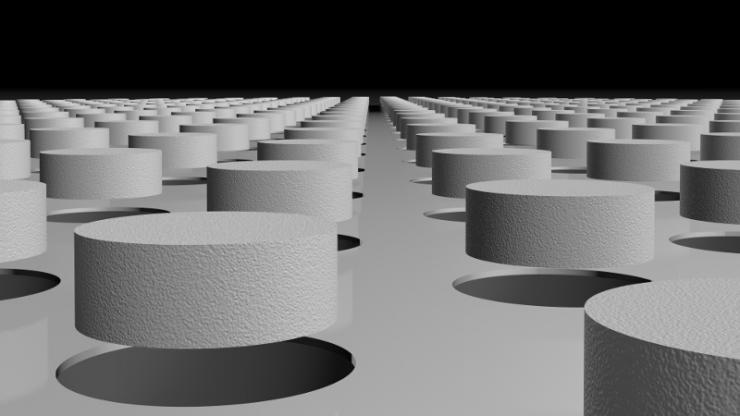Feb 18 2019
Scientists at Duke University have discovered that a flawless absorber of electromagnetic waves they published about in a 2017 paper can easily be tuned into a sort of “time-reversed laser” called a coherent perfect absorber (CPA).
 The width, height, and spacing of the cylinders depicted here dictate how the metamaterial described in the new paper absorbs electromagnetic energy. (Image credit: Duke University)
The width, height, and spacing of the cylinders depicted here dictate how the metamaterial described in the new paper absorbs electromagnetic energy. (Image credit: Duke University)
The study appeared online in the journal Advanced Optical Materials on January 28th.
A laser is a device designed to convert energy into coherent light, meaning the light waves are impeccably aligned with one another. Reversing the process, a CPA—occasionally referred to as a time-reversed laser—is a device that absorbs all of the energy from two identical electromagnetic waves aimed at it from either side in impeccable synchrony. That is, the troughs and crests of their waves penetrate the material from either side at exactly the same time.
In 2017, Willie Padilla, professor of electrical and computer engineering at Duke, built the first material that can absorb nearly 100% of an electromagnetic wave’s energy without having even an atom of metal. The device was a metamaterial—synthetic materials made up of many separately engineered features that collectively yield properties not found in nature.
This specific metamaterial featured zirconia ceramic built into a surface dimpled with cylinders similar to the face of a Lego brick. After computationally modeling the properties of the device by changing the cylinders’ size and spacing, the scientists grasped that they had really designed a more fundamental kind of CPA.
We’ve studied this system before as a perfect absorber, but now we’ve figured out that this device can be configured to be a CPA as well. This study has shown that these seemingly different fields are actually one and the same.
Willie Padilla, Professor of Electrical and Computer Engineering, Duke University.
The CPAs presently illustrated in the literature all have just one mode. They function when the incoming electromagnetic waves are either flawlessly aligned or perfectly out of sync. Padilla and Kebin Fan, a research assistant professor in Padilla’s laboratory, have learned that their flawless absorber is really a CPA with two overlapping modes: it can absorb aligned as well as misaligned waves.
By altering the parameters of the material so that the two modes do not overlap any longer, Padilla and Fan were able to demonstrate it could easily become just like the CPAs currently in the literature, but with a lot more flexibility.
“Typical CPAs have only one variable, the material’s thickness,” said Fan. “We have three: the cylinders’ radius, height, and periodicity. This gives us a lot more room to tailor these modes and put them in the frequency spectrum where we want them, giving us a lot of flexibility for tailoring the CPAs.”
In the paper, the scientists explain that their device can shift between absorbing all phases of electromagnetic waves and only those in tune with one another by just increasing the height of the cylinders from 1.1 mm to 1.4 mm. With this simplicity of transition, they are optimistic that it should be feasible to design a material that can dynamically switch between the two.
“We haven’t done that yet,” said Padilla. “It is challenging, but it’s on our agenda.”
While at present there are no devices that make use of the capabilities of CPAs, Padilla and Fan have some in mind. In theory, scientists could erect a device that calculates not only the intensity of incoming light like a standard camera, but also its phase.
If you’re trying to figure out the properties of a material, the more measurements you have, the more you can understand about the material. And while coherent detectors do exist—we have one in our own lab, actually—they’re extremely expensive to build through other technologies.
Willie Padilla, Professor of Electrical and Computer Engineering, Duke University.
This study was aided by the Department of Energy (DE-SC0014372).